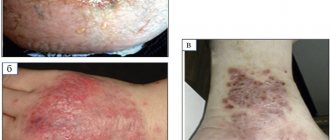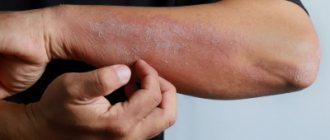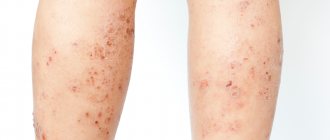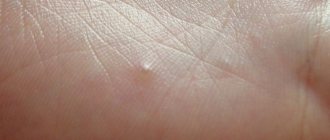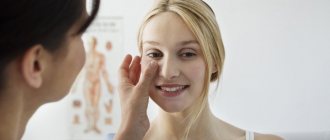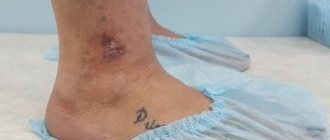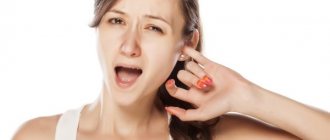28.06.2017
Skin diseases and allergies | Leather
Our skin has a variety of reflex mechanisms that provide an adequate response to external influences. If these effects pose a real or potential threat to the body, skin reactions are protective. For example, in response to heat, surface vessels expand, and in response to cold, they contract. If a parasite appears on the skin, itching occurs - a signal warning the owner about the location of the uninvited guest. Violation of the integrity of the skin leads to the emergency mobilization of a large number of protective cells and the development of an inflammatory reaction designed to prevent the spread of the source of damage to deeper tissues. In response to prolonged mechanical or chemical exposure, thickening and roughening of the skin occurs.
For various skin diseases (for example, eczema), these manifestations - itching, redness, inflammation, etc. are also characteristic. Then the question arises, what distinguishes them from the natural reactions of a healthy body? Not so much the mechanisms responsible for them, but their disproportion to external influences. In another way, this “reactionary inadequacy” is called hypersensitivity or increased reactivity. Moreover, skin hypersensitivity becomes a consequence not only of excessive stimulation by external factors, but also of internal disorders.
Causes of weeping eczema
The exact cause of eczema is unknown, but the development of the disease is influenced by genetic predisposition, the presence of predisposing changes in the functioning of the immune system, allergic predisposition, functional changes in the nervous, endocrine and digestive systems.
Provoking factors may include:
- hereditary predisposition;
- hyperthyroidism;
- diabetes;
- bronchial asthma;
- exudative diathesis;
- changes in hormonal levels;
- ulcers, gastritis and other diseases of the digestive system;
- diseases of the nervous system;
- chronic infections;
- stressful situations;
- allergies to food or medications;
- physical and emotional stress;
- prolonged depression;
- constant contact with chemicals.
The pathology can affect people of all ages, and children are no exception.
Causes of eczema
These internal disorders affect the most important regulatory systems that ensure the internal integrity of the body - nervous, immune and endocrine. And they have genetic roots.
External factors
They cannot be discounted. It is not without reason that among the clinical forms of eczema there are post-traumatic and occupational. The decisive role in the development of a protective reaction of the skin into a painful one is played not so much by the nature of the traumatic effect as by its duration and intensity. Let's list the main ones:
- mechanical impact (friction, scratching);
- thermal effects (too high and low temperatures);
- radiation exposure;
- skin contamination (chemical, physical, biological);
- chemical factors (cosmetics, household chemicals, production agents, drugs, etc.);
- traumatic effects (especially leading to damage to peripheral nerves and the appearance of pathological reflexes);
- biological effects (infectious processes, presence of parasites, etc.).
But even in the presence of these conditions, internal predisposition does not lose its significance.
Internal predisposing factors
Among them:
- Endocrine pathologies and metabolic disorders (for example, diabetes mellitus, ovarian dysfunction, hypo and hyperthyroidism).
- Chronic infectious processes.
- Allergic, autoimmune and other ailments against the background of impaired immune mechanisms.
- Deficiencies of nutrients (eg, unsaturated fatty acids), vitamins (eg, B6) and micronutrients due to both inadequate intake and absorption.
- Pathologies of the gastrointestinal tract leading to impaired digestion and absorption of nutrients (pancreatitis, gastritis, dysbacteriosis, cholecystitis, etc.).
- Pathologies of the excretory system. Malfunctions in the digestive and excretory systems lead to the formation of a large number of toxins in the body, which they themselves cannot eliminate. As a result, the skin, which is also an organ of the excretory system, places an additional toxic load.
- Malfunctions of the autonomic nervous system with a predominance of activity of its parasympathetic department.
- Chronic stress and psycho-emotional trauma.
- Parasitic burden (for example, helminthiasis).
The combined action of internal and external factors leads to the formation and consolidation of hypersensitivity and pathological reaction of skin nerves to irritating influences. As a result, various clinical manifestations of eczema arise.
Symptoms of weeping eczema
In the photo of weeping (dyshidrotic) eczema, signs of the disease are clearly visible. A characteristic symptom of weeping (dyshidrotic) eczema is the simultaneous presence of a rash at various stages of development. Initially, red, swollen spots appear on the skin, later papules with purulent contents and vesicles filled with serous exudate form on their surface. As a result of scratching or on their own, the bubbles open, forming weeping areas on which the exudate is located pointwise, resembling dew drops. Over time, the liquid dries out, forming a peeling crust.
The disease is accompanied by very severe itching, which causes insomnia, irritability and nervousness, and sometimes even leads to reversible mental disorders.
When the disease becomes chronic, the skin turns bluish-reddish and thickens. Often, stagnant spots at the site of the most pronounced rashes and peeling do not disappear even during the period of remission.
A dermatologist can make a diagnosis based on an external examination. To determine the cause of the problem, immunological, allergic and scarification tests are performed.
Symptoms of eczema
The acute phase of the disease goes through several stages and lasts from two weeks to a month. Moreover, changes characteristic of different stages may be present at the same time.
The sequence of symptoms that arise may be as follows:
- Redness, fever and swelling (characteristic manifestations of any inflammatory process) of the damaged area and significant itching. Itching contributes to additional trauma to the skin, which can lead to infectious complications.
- Formation of pink-red nodules (papules) rising above the surface of the skin. Their size is small, no more than 2–3 mm.
- After a few days, existing nodules may become covered with scales (new nodules do not form), and the intensity of the inflammatory reaction noticeably decreases. At this stage there may be a lull. But a transition to the next stage is also possible.
- In place of the nodules, fluid-filled sacs called vesicles are formed. They open, the contents come out (and its character can become purulent) - the weeping stage begins. In place of the opened formations, a red, swollen “bottom” is exposed. The process tends to expand (if the formation of new “bags” continues).
- The process can then go in two ways. Or move on to the stage of drying and formation of crusts. Or it can be complicated by an additional infection (naked areas of the skin are very sensitive to it).
- With a favorable course, the crusts are replaced by scales, then remission occurs.
- Incomplete restoration of the skin (continuing weeping, peeling, redness and swelling) indicates that the process has entered the subacute phase.
- Chronic eczema is considered when a relapse develops at the site of the lesion after a while - a new pathological process.
Repeated repetition of this scenario leads to a permanent change in the affected areas of the skin: thickening, redness, deepening of the pattern. Damaged skin can no longer effectively resist external attacks and is easily damaged by a variety of physicochemical and biological factors.
Where can eczema appear? Theoretically, everywhere (mucous membranes are not affected).
Most often - on the areas most accessible to external influences - on the face and hands. Less often - on the surface of the body and legs. The symmetry of the lesions also serves as a significant diagnostic criterion.
Treatment of weeping eczema
How to treat weeping eczema? To cope with the disease, you will need complex treatment, which includes both medication and therapeutic techniques.
Drug treatment involves the use of both systemic and local drugs.
It allows:
- reduce sensitivity to allergic substances;
- relieve inflammation;
- reduce body intoxication;
Usually the doctor prescribes:
- external anti-inflammatory drugs
- antihistamines with a sedative (calming) effect - eliminate itching, burning, swelling, inflammation and other unpleasant symptoms;
- enterosorbents – absorb and remove toxic substances;
- immunomodulatory agents – strengthen the immune system;
- vitamin complexes.
In addition to symptomatic medications, general remedies aimed at eliminating the cause of the disease will also be needed.
The focus is on topical treatment of weeping eczema. During periods of exacerbation, hormonal drugs and traditional drying agents based on naphthalan and tar, cold compresses from chamomile decoction or oak bark are recommended. Drying agents are prescribed for a short period of time until all the bubbles disappear.
Hormonal drugs provide quick and effective results, but can cause addiction with prolonged use and other undesirable effects, including thinning of the skin. Usually they are used for no more than 2-3 weeks.
After relieving acute symptoms, you will need non-hormonal ointments that have a restorative and exfoliating effect and can prolong remission.
Also during this period you can carry out physiotherapeutic procedures:
- acupuncture;
- ultra-high frequency therapy;
- ultraviolet irradiation;
- ozone therapy;
- phonophoresis;
- laser therapy;
- cryotherapy;
- magnetic therapy;
- phototherapy;
- thalassotherapy;
- paraffin treatment;
- mud therapy.
In addition to taking medications and using ointments, it is necessary to change your lifestyle: eliminate bad habits, walk in the fresh air more often and stick to a diet. You will have to give up smoked meats, fatty, salty and spicy foods, pasta, eggs, seafood, citrus fruits (as well as fruits colored red), strawberries, raspberries, chocolate, honey, coffee, tea, sweet carbonated drinks, and limit the consumption of potatoes . At the same time, it is necessary to provide the body with adequate nutrition and provide it with all the necessary vitamins and minerals.
You should not wait for a complete recovery, as this process is chronic. But if you strictly follow the doctor’s recommendations, you will be able to achieve stable remission and avoid exacerbations.
Treatment of eczema
The main principle of treatment is an individual, comprehensive approach that takes into account both possible external factors and the internal characteristics of “favorable soil” for the manifestation of the disease.
Symptomatic treatment also serves as a component, helping to reduce discomfort and speed up healing.
Regarding external factors that provoke the disease and/or its exacerbation, their identification and elimination play a significant role. For example:
- cleansing the skin of impurities;
- freedom from parasites;
- refusal to use chemical production or household products;
- climate change in the house (heat and dampness can provoke disease);
- protection from direct sunlight, hypothermia, etc.
Correction of internal disorders involves:
- Changing eating habits (excluding foods that aggravate internal imbalances and including missing nutrients - vitamins (group B), microelements (sulfur, zinc, cobalt), unsaturated fatty acids, etc.).
- Detection and elimination of chronic foci of infection.
- Getting rid of helminths (and other internal parasites).
- Treatment of systemic diseases (nervous, endocrine, immune, digestive system, etc.).
- Increasing the body's resistance to stress and liberation from the consequences of psycho-emotional trauma.
In general drug treatment of eczema itself, the following classes of drugs are used:
- anti-inflammatory (including hormones);
- antibacterial;
- sorbents;
- laxatives;
- sedatives;
- general strengthening;
- desensitizing agents (ascorbic acid, calcium chloride, histamine release inhibitors), etc.
The local use of certain medications is determined by the stage and type of eczematous process. It is important to consider the habituation factor. Therefore, the drugs used must be changed periodically. The most important thing is that local therapy can only bring short-term relief, but not lead to a cure.
Physiotherapeutic procedures can be classified as both local and general therapeutic effects. The following types are used as part of the complex treatment of eczema:
- ultraviolet irradiation;
- cryotherapy and cryomassage (cold exposure);
- magnetic therapy;
- exposure to alternating current;
- laser treatment (both locally to the affected area and blood irradiation).
Dry eczema on the hands and feet. Treatment
This type affects only the superficial, but also the deep layers of the skin (dermis) and is characteristic mainly of older people. It is characterized by dryness, loss of elasticity, peeling, the appearance of deep cracks, ulcerations, pain and itching.
Local treatment using various ointments, creams, gels (on a natural basis) is aimed at reducing pain and itching, softening and eliminating dryness and flaking, preventing infection, restoring blood supply and innervation.
The active components often include: acetylsalicylic acid, panthenol, urea, naphthalan, novocaine, etc.
Physiotherapeutic procedures are possible.
Dyshidrotic eczema on the arms and legs. Treatment
Also, like the previous version, it mainly affects the feet and hands.
A characteristic element is pea-sized bubbles of dense consistency, which, if their integrity is violated, forms an erosive surface with droplets of “dew” - serous fluid. The affected area is marked with clear boundaries. The principles of general and local therapy are similar to those stated above.
Weeping eczema. Treatment
This type is one of the stages of development of the eczematous process.
To speed up the restoration of the skin and reduce discomfort at this stage, astringent, drying, antimicrobial, antipruritic drugs (lotions, ointments, creams) are used.
Microbial eczema. Treatment
The basic therapeutic principles are the same.
To speed up healing, doctors often advise conducting a bacteriological study and, based on it, targeting microorganisms responsible for complicating the process.
Seborrheic eczema. Treatment
It mainly affects areas with a large number of sebaceous glands (armpits, scalp, ears, cheeks, nasolabial triangle, etc.). Characterized by clearly defined, scaly yellow-pink spots covered with crusts.
The basic therapeutic principles are the same.
Non-hormonal treatment of eczema
Hormonal medications (mainly in the form of ointments containing hormones) are usually prescribed to relieve inflammation that is difficult to treat with other therapeutic interventions. This therapy has its pros and cons. The advantage is the disappearance of disturbing symptoms. The downside is the fragility of the achieved effect, the acquisition of addiction, adverse reactions and the risk of deepening the process. This does not mean damage to deeper tissues, but a change in the nature of the pathology - the emergence of new symptoms of ill health of the body as a whole. These symptoms may not be directly related to the previous diagnosis and create the impression of a cure for an old disease and the acquisition of a new one.
Are there alternatives? The specific answer is always individual. It is determined by the holistic picture of a person’s disease (and associated pathologies), the position of the attending physician, previous therapy and its results, the choice of methods used, etc.
One alternative would be to treat eczema with homeopathy or other methods of holistic medicine (acupuncture, herbal medicine, osteopathy, etc.).
Zinc-naphthalan paste Losterin for weeping (dyshidrotic) eczema
One of the effective remedies in the treatment of the acute stage of weeping (dyshidrotic) eczema is zinc-naphthalan paste Losterin. It has a drying and adsorbing effect, relieves itching, reduces the inflammatory component and prevents the development of secondary infection.
The composition of Losterin paste includes deresined naphthalan (3%) and zinc oxide (25%). The paste does not contain hormones and does not cause withdrawal symptoms or other unwanted complications. Therefore, it can be used daily (usually 3 to 10 days)
Prevention of weeping (dyshidrotic) eczema
To prevent relapses, it is recommended:
- “forget” about bad habits;
- avoid contact with allergens;
- maintain the correct daily routine, take time for proper sleep;
- stick to a diet;
- eliminate nervous stress;
- avoid stressful situations;
- avoid visiting bathhouses, saunas and other places where exposure to water and high temperatures is combined;
- do not overheat or overcool the body;
- wear cotton clothes;
- timely treat various diseases;
Maintaining body hygiene is especially important. But you should not use hygiene products containing alkalis and chemical fragrances, as they can provoke an exacerbation. It is best to purchase hypoallergenic products from the Losterin series (shampoo, shower gel and cream soap). They do not irritate the skin and are recommended for daily use.
Bibliography
- Ado A.D. General allergology. M.; "Medicine", 1970.-543 p.
- Alekseeva, O.G. On the methodology for determining the allergenic properties of chemical substances / O.G. Alekseeva, A.I. Petkevich // Hygiene and sanitation. 1973. - No. 3. — P. 64-67.
- Belousova, T.A. Dermatophytosis (skin mycoses) is an urgent problem of modern dermatology. Electronic resource. // Russian medical journal. 2003. No. 17. - Access mode: https://www.dennatolog4vou.rn/stat/rmi/dermatofitii act probl.html, - Cap. from the screen.
- Zheltakov M.M. Issues of allergy in dermatology // Bulletin of Dermatology and Venereology.-1962.- No. 9.- p. 3.
- Zibitsker D.E. Bacterial and drug allergies. Minsk, “Belarus”, 1996.- 223 p.
- Kamyshnikov, BC What do medical tests say: A reference guide / BC Kamyshnikov. Minsk: Belarusian Science, - 1997. - 189 p.
- Chernukh AM Frolov E.P. Inflammation of the skin // Skin.-M.: Medicine, 1982.-p.193-230.
- Shaternikov V.A., Konyshev V.A., Mazo V.K. Structure and properties of food allergens // Nutrition Issues. - 1980. - No. 1. - S.Z.
